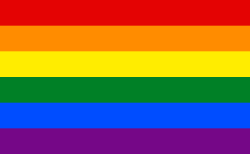Bi-curious
| Sexual orientation |
|---|
| Sexual orientations |
| Non-binary categories |
| Research |
| Non-human animals |
|
| Part of a series on |
| Lesbian, gay, bisexual, and transgender (LGBT) people |
|---|
 |
| Sexual orientation |
| History |
| Culture |
| Rights |
| Social attitudes |
| Prejudice / Violence |
|
Academic fields and discourse |
|
|
Bi-curious is a phenomenon in which people of a heterosexual or homosexual identity who, while showing some curiosity for sexual activity with a person of the sex they do not favor, distinguish themselves from the bisexual label. The term is sometimes used to describe a broad continuum of sexual orientation between heterosexuality and bisexuality.[1] Such continuums include mostly-heterosexual or mostly-homosexual, but these can be self identified without identifying as bisexual.[2] The terms heteroflexible and homoflexible are also applied to bi-curiosity, though some authors distinguish heteroflexibility as lacking the "wish to experiment with ... sexuality" implied by the bi-curious label.[3]
The term bi-curious implies that the individual has either no or limited homosexual experience in the case of heterosexual individuals or no or limited heterosexual experience in the case of homosexual people, but may continue to self-identify as bi-curious if they do not feel they have adequately explored these feelings, or if they do not wish to identify as bisexual.
References
- ↑ Frank, Katherine (2008). "'Not Gay, but Not Homophobic': Male Sexuality and Homophobia in the 'Lifestyle'". Sexualities. 11 (4): 435–454. doi:10.1177/1363460708091743.
- ↑ Savin-Williams, Ritch C., Kara Joyner, and Gerulf Rieger. "Prevalence and stability of self-reported sexual orientation identity during young adulthood."Archives of sexual behavior 41.1 (2012): 103-110.
- ↑ Smorag, Pascale (14 May 2008). "From Closet Talk to PC Terminology : Gay Speech and the Politics of Visibility". Transatlantica. Retrieved February 13, 2011.
